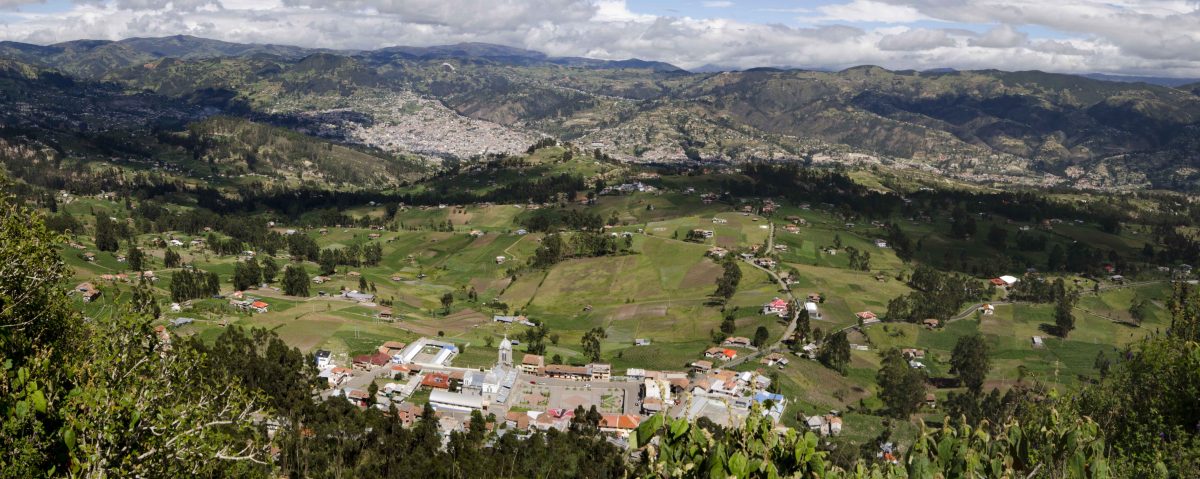One of the things I love about taking road trips are the surprises we find along the way. As we were driving from Ingapirca to our next stop on the road, Cuenca, we noted an official sign along the side of the higway, small and brown with white writing that tells you without even reading that a cultural place of interest is nearby. This one advertised an archeological site a few kilometers up the road near the town of Cojitambo. We decided to take a look.
And we ‘discovered’ a location that, for us, was more intriguing than the temple at Ingapirca. We did not find a huge temple or a palace but nor did we share the grounds with any other tourists. In fact, the only other people around were a few local couples enjoying the sunny afternoon and a man we assume was a caretaker of the site as he was cutting grass by hand. His job would be a full time one because by the time he would clear one section, the others would be ready for attention.
 A few years back, archeologists visited this site and prepared it for visitors. Signs explain that the remaining walls, petrogylphs, and tons of ancient ceramics support the theory that several cultures lived in this location. People who lived simply occupied this area from 500BC to 500AD and a more advanced civilization occupied the area from 500AD until the arrival of the Inca in approximately 1450AD. At that point, the Inca added to the existing structures and remained in place until the Spanish Conquest in 1532.
A few years back, archeologists visited this site and prepared it for visitors. Signs explain that the remaining walls, petrogylphs, and tons of ancient ceramics support the theory that several cultures lived in this location. People who lived simply occupied this area from 500BC to 500AD and a more advanced civilization occupied the area from 500AD until the arrival of the Inca in approximately 1450AD. At that point, the Inca added to the existing structures and remained in place until the Spanish Conquest in 1532.
The name alone tells us something about the site. According to the Ministry of Tourism in Ecuador, the entire name comes from the Quechua Curi Tambo, which meant Resting Place of Gold. The word curi refers to gold but nothing at the site mentions finds of gold, only of ceramics. The word tambo refers to a resting place or a stop on the road. The Inca generally built tambos a day’s travel from one another, about 30 kilometers apart for a fast runner or chasqui.
The only remaining building at Cojitambo is a small one and is lacking a roof and lintel over the doorway. It is interesting for the multiple niches built into its walls, a very typical Incan detail. However, it was built using mortar and few of the stones are shaped as would be found in a ceremonial building of the Incan Imperial Style. This tells us that Cojitambo was more important as a military stronghold or just as a stopping point along the trail connecting Quito to Cuenca and eventually to Cuzco, the capitol of the Incan Empire.
 An area built up like a stage with accompanying space for an audience has retaining walls that are constructed without mortar but with unshaped stone. And just in the center of where you would expect the audience to sit are the remains of an ancient well.
An area built up like a stage with accompanying space for an audience has retaining walls that are constructed without mortar but with unshaped stone. And just in the center of where you would expect the audience to sit are the remains of an ancient well.
We had a wonderful time wandering up and down the hillside, stepping into the ancient building, reading modern graffiti while contemplating the history of this place, and searching for the petroglyphs that are said to be carved into the hillside but which we were not lucky enough to find. Have to save something for a return visit, right?
For those without a vehicle, this location can still be visited with a little planning. It is only 12 kilometers outside of Azogues, a major city and possible tourist destination, and 30 kilometers outside of Cuenca, a major tourist destination and the retirement spot for thousands of Americans. Many local tourist companies in both locations would be willing to arrange a trip.
- From the far side of the hill where the ruins lie, it is possible to look down on the town of Cojitambo.
- Part of the pleasure of touring this site was approaching it from below and walking across the open field and up the terraced hillside.
- A wall made without mortar from uncut stone.
- Many of the steps at this site have once again been overgrown by grasses. Sites such as these need constant maintenance.
- This is the view of Cojitambo from the gravel road that runs to the top of the hill.
- A closer view of the Incan built structure with niches.
- This is the view of surrounding farmland as seen from the heights of Cojitambo.
- This photo shows a raised platform on the right hand side and a large open field on the left, remains of an ancient amphitheater perhaps.
- Niches and graffiti.
- The small building with niches and surrounding countryside.
- This is the main plaza and church in the town of Cojitambo.
- The people who worked hard to make this archeology site available to tourists like ourselves.
- This is the predominate collection of structures at Cojitambo.
- A view of the complex and the surrounding Andes.
- Cojitambo as seen from the gravel road.
- A closer view of the niches and the cut stone used to make them.





























0 comentarios